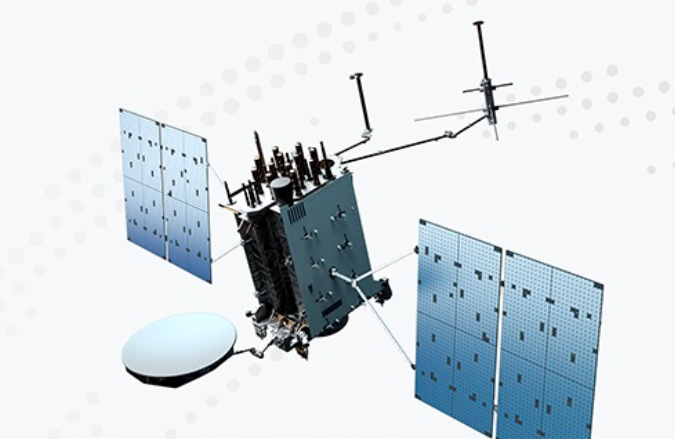
GPS IIIF, Lockheed Martin image
UPDATED: To clarify that Lockheed Martin is upgrading, but doesn’t own, the current GPS ground segment operating system.” WASHINGTON: Raytheon will deliver its long-delayed Next Generation Operational Control Segment (OCX) ground system for GPS to the Space Force later this year, as promised, says program manager Jeff McCall.
“We are still tracking to those to those commitments,” McCall said in an interview yesterday. Raytheon Intelligence & Space will finish qualification of the baseline OCX software and deliver it to Space Force this year for validation; and “final handover” of “the software and hardware that the system is going to run on” will take place in 2022.
Raytheon’s baseline OCX software, once it is up and running next year, will be used to control the GPS satellites now in operation, McCall said, including GPS IIR, GPS IIR-M and the newest GPS III model birds.
(Lockheed Martin spokesperson Chip Eschenfelder said yesterday that four GPS III satellites are now on orbit; “GPS III Space Vehicle 05 (GPS III SV05) is launching this June.”)
UPDATE BEGINS. Currently, all the GPS satellites on the government’s current GPS control system, called OCS for Operational Control System. (Yes, it is confusing). Until OCX takes over, Lockheed Martin has been contracted to sustain the OCS through 2025, as well as provide a series of stop gap software upgrades. Those upgrades now allow the OCS to ‘fly’ the more powerful GPS IIIs (and the rest of the constellation) and task, upload and monitor the encrypted M-Code signals. UPDATE ENDS.
“The transition from the OCS system today to the OCX system in the future is going to be managed by the US Space Force,” McCall said. Raytheon I&S, he added is “doing a number of risk reduction activities” to ensure that transition “can be executed by the US government.”
McCall, who has been in his position at Raytheon Intelligence & Space only for a few weeks (previously serving as deputy), was enthusiastic about recent progress by the OCX program, despite the obstacles thrown up by the COVID-19 pandemic. OCX has had a troubled history, to say the least — including a serious Nunn-McCurdy breach back in 2016 that drew the wrath of Frank Kendall, then DoD acquisition czar and now the Biden administration nominee for Air Force secretary.
“Lots of exciting things happening on the program right now,” he said.
New Software For GPS IIIF
In the latest success for the program, Space and Missile Systems Center (SMC) just announced a new, $228 million contract for the company to tweak the baseline OCX software so it can manage the newest generation of Lockheed Martin-built Global Positioning System satellites, the GPS III Follow-on aka GPS IIIF. Those new satellites will sport a number of upgrades, including a higher-power, more jam-resistant signal called Regional Military Protection (RMP); and, a DoD-provided search and rescue payload, according to Lockheed Martin’s website.
The new OCX 3F software, therefore, is being specially designed ton include new features necessary to accommodate the new types of data being downlinked from those GPS IIIF satellites when they are launched, McCall explained.
For example, he said, GPS IIIF will “have different telemetry points that it sends down, it has new features that can be controlled.” So there are software “tools that I need to put in my toolbox so that I can exercise the new capabilities of the IIIF satellites.” He stressed, however, that “there’s no new equipment, or hardware, required to fly the GPS IIIF, it’s all software work” involved in the OCX 3F contract.
Raytheon will deliver the OCX 3F software in 2025 to the Space Force, McCall said. And the Space Force will then decide how and when it integrates that new software package into the baseline Block 1/Block 2 OCX software. This is because once delivered and accepted, Space Force will own the OCX software, not Raytheon.
The Space Force currently plans to begin launching the GPS IIIF satellites in 2026, Lockheed Martin spokesperson Chip Eschenfelder in an email yesterday. The company in 2018 won a $7.2 billion contract to build up to 22 GPS IIIF birds. “The Space Force has exercised options for four GPS IIIF satellites so far (SVs 11-14),” Eschenfelder said.
OCX Monitor Stations Deployed
Further, McCall explained, as of yesterday, 13 of 17 the GPS monitor stations that keep tabs on the health of the satellites are now deployed worldwide. And four of the five elements that make up the OCX ground segment have been blessed by the Space Force:
- GPS OCX high-fidelity GPS system simulator (GSYS): A high-fidelity GPS system simulator developed under OCX program. The GSYS models critical tasks of GPS ground control, “including managing 17 signal monitoring stations, tasking 11 command and control antenna sites, and directing the entire lifecycle, from launch to disposal” of the birds, McCall explained in an email.
- Global Information Grid Automated Information System Element (GGAE): This subsystem “receives GPS status updates and data from the GPS OCX Master Control Station and alternate control stations and then provides web services and a display portal for armed forces users to access information.”
- Legacy Ground Antenna Element (LGAE): Four physical ground antennas that are used for “direct command and control of the GPS constellation.”
Norway’s top officer on his ‘biggest challenge,’ next frigate and new NATO neighbors
Gen. Eirik Kristoffersen, Norway’s Chief of Defense, talks to Breaking Defense about his plans for spending on new frigates and subs, the challenges of upgrading Norway’s “digital backbone” and refilling the military’s stocks.



























